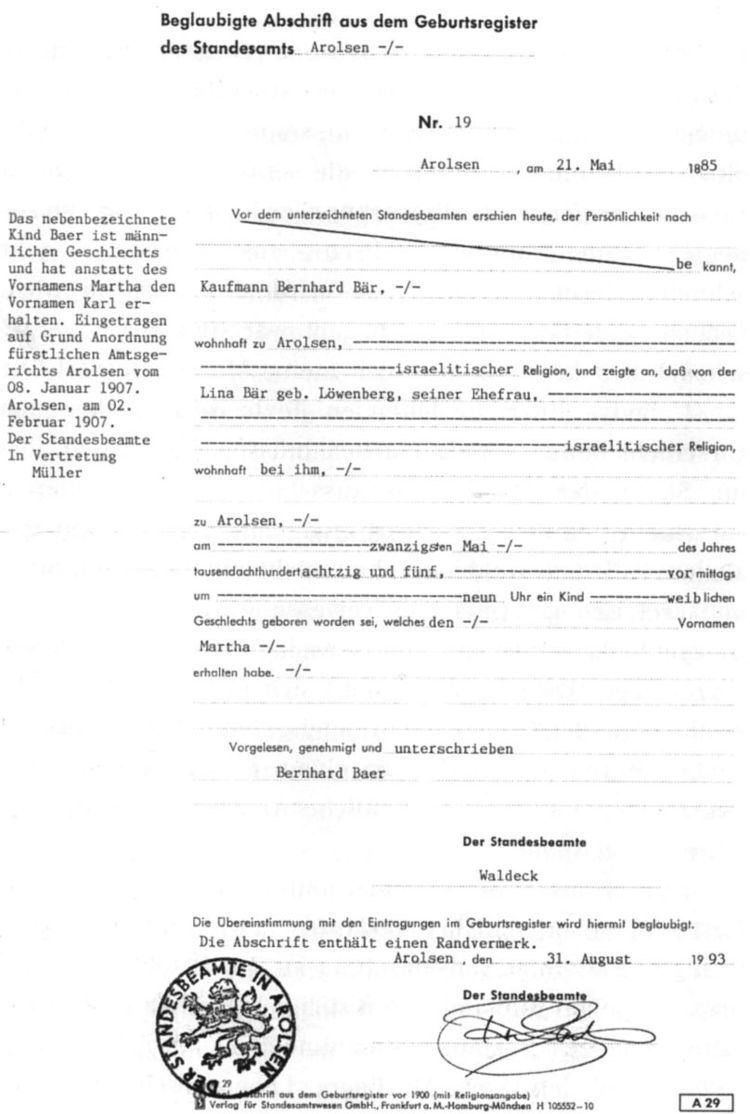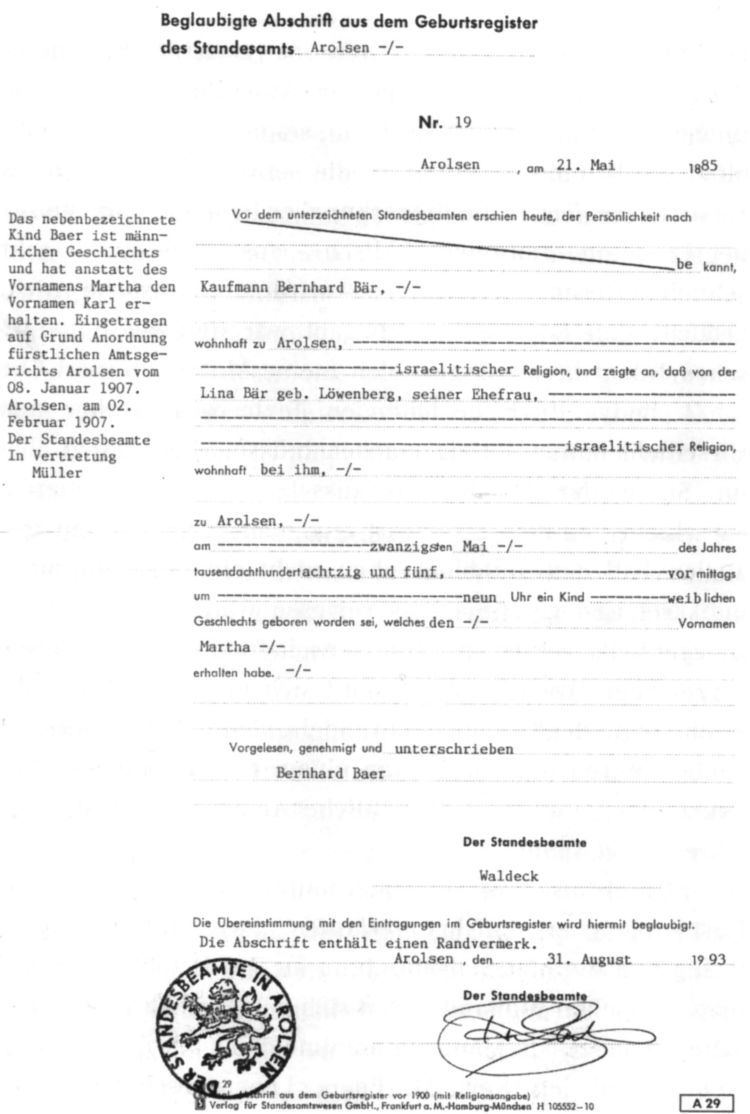Name Karl Baer | Role Author | |
 | ||
Died June 26, 1956, Bat Yam, Israel | ||
Karl M. Baer (20 May 1885 – 26 June 1956) was a German-Israeli author, social worker, reformer, suffragette and Zionist. Assigned female at birth and named Martha Baer he became, in December 1906, one of the first people to undergo sex-change surgery, and one of the first, in January 1907, to gain full legal recognition of his gender identity and to have a new birth certificate issued reflecting his new gender. Baer wrote notes for sexologist Magnus Hirschfeld on his experiences growing up as a girl while feeling inside that he was male. Together they developed these notes into the semi-fictional, semi-autobiographical Aus eines Mannes Mädchenjahren (Man's Years as a Young Girl) (1907) which was published under the pseudonym N.O. Body. Baer also gained the right to marry and did so in October 1907.

Martha Baer studied political economy, sociology and pedagogy in Berlin and Hamburg, and became a social worker ("Volkspflegerin") and confirmed Suffragette. In May 1904 he was sent to Galicia under the auspices of the Hamburg chapter of the B'nai B'rith, to campaign against the trafficking of women from poor countries and for the rights of all women to education. Here, in Lemberg (now Lviv), Martha met the equally active Beile Halpern, who he was later to marry (as Karl Baer).
Baer's work included activism among local women. He encouraged them to campaign for kindergarten and school provision, which would allow women to hold jobs outside the home and reduce the financial hardship that prompted some to traffic their daughters or send them into service. Baer worked to oblige the authorities along established human trafficking paths to check ID documents and combat illegal movement. He also promoted the women's education movement, and became well known as a reformist throughout eastern Europe and Germany.
Baer had initially been sent to Galicia for two years; he returned to Germany after only one, having attracted censure for his male body language, argumentative style, and forceful advocacy of the cause. According to case notes by Magnus Hirschfeld, Baer then transitioned to his male identity and began living as a man. He was diagnosed as a man living in a woman's body after accidental hospitalization, when his female anatomy was discovered; at the same hospital he underwent multi-stage rudimentary sex-change surgery in October 1906. After convalescence he was released from hospital in December 1906, with a medical certificate of his new gender. His new identity was confirmed by the courts in Arolsen (his birthplace) on 8 January 1907.
Karl M. Baer
Karl Baer retained the middle initial "M", ostensibly stemming from 'Martha', to connect him to his earlier publications under the name M Baer. In later life he said the letter stood for 'Max'; on his gravestone the middle name is given as 'Meir.' In October 1907 he married Beile Halpern; she died in March 1909, and he remarried, with Elza Max (1887–1947). From 1908 to 1911 Baer was an insurance sales agent; on January 1, 1911 he took up a post as Consul for Jewish Life in Berlin. In December 1920 he became director of the Berlin Section of the Loge B'nai B'rith, a post he held until the Section's forcible closure by the Gestapo on 19 April 1937. Baer was by then an important figure in Jewish society, and his influence on cultural life brought him into conflict with the Nazi administration. He was allowed to emigrate with his wife in June 1938 to Palestine, later to become Israel, where he worked between 1942 and 1950 as an accountant. By 1950 he was going blind and had to give up his job; nothing more is documented about him up to his death in 1956. He is buried in the Kiryat-Shaul cemetery in Tel Aviv under the name Karl Meir Baer.
As part of his analysis and therapy, Baer wrote notes for Hirschfeld on his experiences growing up as a girl while feeling inside that he was male. He and Hirschfeld together worked up these notes into the semi-fictional, semi-autobiographical Aus eines Mannes Mädchenjahren, "Memoirs of a man's maiden years", published in 1907 under the pseudonym 'N.O. Body.' Details of Baer's background were also changed to prevent readers identifying him from the text. Hirschfeld, a keen advocate of the notion of a 'third sex', to which anyone uncomfortable with gender norms or sexual dichotomy could attribute themselves, hoped the book would explain the dilemma that many intersexed children suffered when forced into a two-gender system. The book went through several reprints and translations, earning Baer a continuing income in later life. Later editions, especially those published after the First World War, were rewritten in light of shifts in social acceptance and to fulfil new social and political aims.
In 1919 Karl Grune adapted Baer's book into a fictional autobiography, and into the script for a silent film starring the German actress Erika Glässner (1890–1959) as "Nobody". No copy of the film seems to have survived the Nazi period and Second World War.
Writer Hermann Simon, whose aunts and mother were friends of Baer and his wife, wrote a mini-book, Wer ist Nobody? ("Who is Nobody?") for inclusion in a 1993 print edition of Aus eines Mannes Mädchenjahren
An English translation by Deborah Simon, based on a German post-war reprint, was published in 2005 under the name Memoirs of a Man's Maiden Years.
